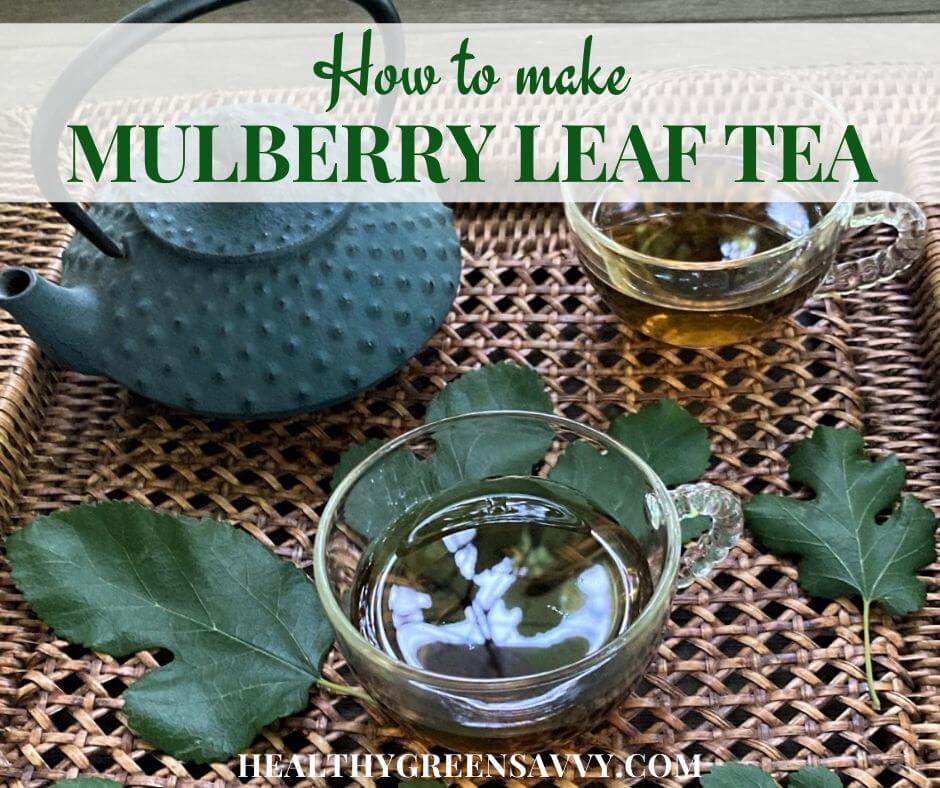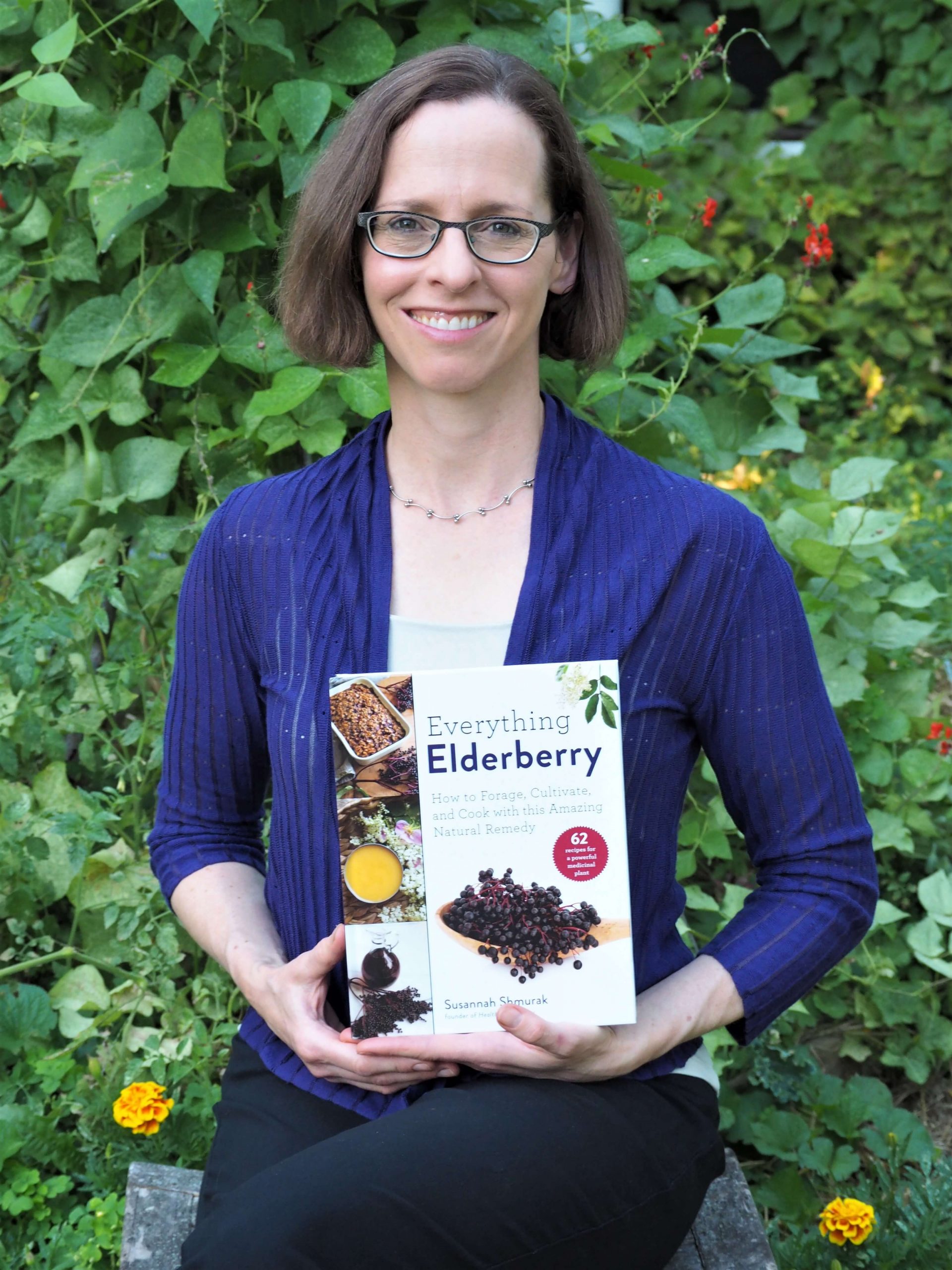Last Updated on October 23, 2024
Did you know that mulberry tree leaves can be brewed into a tasty tea? Before you can harvest the delicious fruit for mulberry recipes, you can use mulberry tree leaves to make tea. Here’s how to make mulberry tree leaf tea from fresh or dried mulberry leaves and what to know about mulberry leaf tea benefits.

WHY MAKE MULBERRY LEAF TEA?
A longtime tea aficionado, I’m generally of the opinion that if you’re going to have a drink, it may as well have some extra benefits as well as taste really good.
Mulberry tree leaf tea fits the bill: Full of health-supporting compounds and very tasty, too! Plus, as an easily-foraged plant, mulberry leaves are free for the taking.
Homemade herbal teas like mulberry leaf tea taste wonderful and can help us get extra servings of healthy plant compounds called polyphenols. I love to make elderflower tea, dandelion tea, and elderberry tea or ginger tea with orange peel when I’m fighting off a cold. When I want a refreshing drink, I have borage leaves in my homemade seltzer or hibiscus tea over ice. So good!
I also love to brew tea from nearby conifer trees. Spruce tea and pine needle tea are both delicious and rich in polyphenols. You might be surprised to find that there are dozens of other medicinal trees to forage from. If you have a ginkgo or birch growing near you, you can go grab some leaves and make a foraged ginkgo biloba tea or birch tea.
Creeping Charlie can also be brewed into a highly medicinal tea. It’s a bit of an acquired taste, but it’s worth trying. Here’s what to know about creeping Charlie uses. Edible clover flower tea or neutral-tasting goldenrod tea are among the numerous wild herbs you can forage to make delicious wild tea.
It’s incredible that even in my tiny yard I’m always finding new things to harvest. Though we’ve had mulberry trees for over a decade, I only learned recently that in addition to the delicious mulberries, mulberry leaves have superfood status as well.
Knowing that my prolific mulberry trees offer not just one, but two highly nutritious crops is such a fun addition to the herbal tea toolkit. I now enjoy drinking fresh mulberry leaf tea in summer and dry my own mulberry leaves for winter use.
ARE MULBERRY TREE LEAVES POISONOUS?
While some people may be sensitive to the milky sap in parts of the mulberry tree, mulberry leaves are frequently used in cooking, so no, they’re not poisonous. As with other foods, some people may be more sensitive and experience stomach upset, but the occasional cup of mulberry leaf tea shouldn’t pose a problem for most people.
One source claims that the sap in white mulberry plants is toxic to humans, but white mulberry leaf is often sold for tea that’s been enjoyed around the world. As with any new herb, always try a small amount to make sure it agrees with you before consuming it in quantity.
MULBERRY LEAF TEA BENEFITS
While plenty of folks get excited about mulberries, one of those dark-purple superfood berries you can find in abundance on neighborhood trees, very few of us realize that the leaves of the mulberry tree have benefits as well.
Traditional Chinese medicine (TCM), however, has used mulberry leaves for centuries. White mulberry leaf, or Sang Ye, is considered a cooling herb used to address heat and to support the liver and lungs. Mulberry leaf is usually combined with other herbs to address specific health issues.
Like pine needles and elderberries, mulberry leaves are being studied to understand how their bioactive compounds affect the body. Note that many of these studies were conducted on animals, so there’s not much data on how mulberry tree leaves affect human health. Some studies use white mulberry leaf, while others don’t specify which mulberry species they used.
1. MULBERRY TREE LEAVES CONTAIN ANTI-INFLAMMATORY COMPOUNDS
Research has shown mulberry tree leaves to be high in antioxidants, which can help reduce oxidative stress, a condition linked to many chronic diseases. Studies have found that extracts of mulberry leaves exhibit anti-inflammatory effects in mice.
Other antioxidant-rich teas worth exploring include hawthorn berry tea, hibiscus tea, and rose hip tea
Here are loads more antioxidant-rich superfoods.
2. MULBERRY TREE LEAF MAY PROVIDE PAIN RELIEF
Used as a pain reliever in Brazilian folk medicine, mulberry tree leaves demonstrated pain-relieving effects in a study using mice.
3. MULBERRY TREE LEAF MAY BENEFIT BLOOD SUGAR AND METABOLISM
Mulberry leaves are being studied for their potential to benefit metabolism and address obesity. In a small human study, mulberry leaf extract was found to have a positive impact on blood glucose.
One study also found that animals fed mulberry leaves showed improvement in liver and kidney function.
4. MULBERRY LEAF MAY HELP CHOLESTEROL AND VASCULAR HEALTH
Mulberry tree leaves appear to have a positive impact on cholesterol and protect against atherosclerosis, according to a study of rabbits fed a high cholesterol diet.
5. MULBERRY TREE LEAVES CONTAIN COMPOUNDS THAT MAY INHIBIT CANCER
Mulberry tree leaf’s antioxidants are among the many undergoing investigation for their use in fighting cancer. An in vitro study of white mulberry leaf extract found it inhibited human cancer cells.

HOW TO IDENTIFY MULBERRY TREE LEAVES
Mulberry trees are very easy to identify once the fruit is forming, as no other tree has berries that look like blackberries dangling from them. Here’s more about foraging edible mulberries.
Mulberries start ripening toward the end of June in my area, around the same time all the juneberries are pouring in. Luckily, mulberries ripen over a long period of time, so you can pick the ripe ones and come back for more for many weeks.
Mulberry trees may produce black, red, or white berries. They can vary in size from under 1/2″ to over 1 1/2″ long, depending on the variety and growing conditions.
From the genus Morus, the mulberry trees found in North America are most commonly the species introduced from Asia, Morus alba, or white mulberry (though confusingly, its ripe fruit is a dark purple-black). Less common but native to North America is Morus rubra or red mulberry and Morus microphylla, also known as Texas mulberry. Another introduced species, Morus nigra, or black mulberry, isn’t common and can mainly be found in the southern part of the United States.
One of my favorite foraging experts, Samuel Thayer, notes in Incredible Wild Edibles that the fruit color isn’t a reliable way to identify the species, as many Morus alba (a.k.a. white mulberry) berries ripen to a dark purple. He calls these Asian mulberry to reduce confusion, and says they’re the most common type of mulberry found in North America, while Morus nigra, which also have dark purple fruit are rarely found wild. He refers to the native Morus rubra as American mulberry, and notes that it’s often mistaken for basswood.
Thayer reports that the red mulberry has better-tasting leaves than the Asian mulberry, saying that “they’re the best green from any woody plant in North America.” If you find one, he recommends them both raw and cooked.
We have Asian mulberry trees growing in our yard, and since these are the most commonly-found types of mulberry tree, the description below focuses on those.
Here are the identifying features to look for when foraging mulberry tree leaves:
LEAVES
Mulberry tree leaves can vary in shape by variety and even on an individual tree, but they grow in an alternate pattern and are often lobed or heart-shaped. Especially in young plants, the lobed leaves often resemble those of fig trees, which are in the same family.
Leaves are simple (rather than compound like elderberry), with short petioles (stems where they attach to the branch). They typically have serrated edges. Mulberry leaves tend to be glossy and may have fine hairs on the larger veins on the underside of the leaf. You have to look pretty carefully to notice them.
Here’s a sampling of the leaves on our mulberry trees:

BERRIES
Mulberries are typically more elongated than the blackberries they resemble, with a pithy center that comes off with the berry (unlike wild black raspberries, which have a hollow center). They can be quite small, less than a 1/2 inch or so, or considerably longer, up to 1 1/2 inches.
BARK
Grey-brown, smoother when younger. Older bark will have fissures. Here’s a photo of the two trunks of one of the mulberry trees animals planted at the edges of our yard:

HABITAT
Mulberries grow in much of Europe, the Americas, South Asia, and North Africa. Often planted by birds, mulberries can be found growing wild in a number of environments. You’ll often find them on the borders of parks and farms, and possibly in your own yard, as I have.
Asian mulberry prefers sun, while American mulberry tolerates shade and is more likely to be found in the understory of forests than Asian mulberry trees.
–> Remember to always consult a good field guide or go with an experienced foraging expert so you’re sure you’ve correctly identified mulberry trees. These are some of the best foraging books I’ve found.
Consider taking a foraging class like the Herbal Academy’s online foraging course, which teaches plant identification and ethical wildcrafting practices.
HARVESTING MULBERRY TREE LEAVES
Mulberry leaves may be harvested at any stage of maturity, though traditionally they are harvested after the first frost or when they have started to yellow in fall.
If you’re eating mulberry tree leaves rather than brewing tea from them, choose the younger leaves, which will be more tender, especially if picked earlier in the season. Mulberry tree leaf can be used in recipes in much the same way you use grape leaves, or can be included as a sauteed or stir-fried green.
Young mulberry leaves are among the many edible wild greens you can forage for this season.
For brewing fresh tea, you only need a few leaves for a cup of tea, but you can harvest more to dry them. If you prefer the flavor of fresh mulberry tree leaf, you can store them in an airtight container in the refrigerator for a few days.
Always harvest mulberry leaves from a tree that hasn’t been sprayed with chemicals. Note that many public parks have been sprayed with herbicides.
HOW TO DRY MULBERRY LEAVES
Your best bet for drying most leaves for herbal teas is a drying screen.
I highly recommend a collapsible drying screen. I love that it has tons of space for laying out the many different herbs I gather each season but folds up into a small circle that I can tuck away out of season.
I’ve used it to dry huge quantities of foraged Canadian wood nettle, plantain, linden flowers, goldenrod, elderflowers, birch leaves, and so much more.
You need dry air for a drying screen to work, so if your house is humid, you’ll need to use a dehydrator. I prefer stainless steel dehydrators like this one to the plastic sort if you’re in the market for one. They last forever and are fantastic for putting up huge quantities of dried fruit from your garden. We use ours tons for drying bananas, apples, peaches, and plums as well as making delicious homemade fruit leather from our plentiful rhubarb.
To dry mulberry leaves: Place harvested leaves on your drying screen or dehydrator trays. Leave on the drying screen until brittle (or leave in the dehydrator on low heat for a few hours).
Store leaves whole if possible and crumble when ready to use.
Here’s more on preserving herbs if you want to have useful medicinal herbs at the ready all year round.
SHOULD YOU USE FRESH OR DRIED MULBERRY LEAVES FOR MULBERRY LEAF TEA?
Either fresh or dried mulberry leaves work for making mulberry leaf tea. Fresh leaves may retain more of their beneficial compounds, but dry mulberry leaf is typically used in TCM.
WHAT DOES MULBERRY LEAF TEA TASTE LIKE?
Fresh mulberry tree leaves make a smooth, pleasant-tasting tea reminiscent of green tea. It’s a bit fruity and a little sweet.
As with most herbs, dried mulberry leaves make a tea with a slightly different flavor than tea made with fresh leaves.
You can combine mulberry leaves with other herbs to alter the flavor. Hibiscus, borage, or mint would all work well with mulberry leaf tea.
DOES MULBERRY TREE LEAF TEA HAVE CAFFEINE?
Mulberry leaves do not have any caffeine, making them a good choice for those trying to limit caffeine intake or for later in the day, when you don’t want caffeine in your system to interfere with sleep. Here are some herbs that help sleep if you want something to encourage a better night’s rest.
RECOMMENDED SUPPLIES FOR MULBERRY LEAF TEA
All you need to make mulberry leaf tea is mulberry tree leaves and hot water, but some helpful gear can take your mulberry leaf tea up a notch.
Most important is a quality water filter. Most municipal water supplies contain scores of unregulated chemicals that you don’t want in your healthy tea! Here’s what to know about choosing an effective water filter. You may be surprised to learn that most popular filters leave lots in your water that you’d rather not drink.
Some other tools to help with your mulberry leaf tea-making:
Can’t forage your own fresh mulberry tree leaves? Here are some sources on Amazon for dried mulberry leaf, and here are some on Etsy. Some Etsy sellers also stock fresh mulberry leaves if you prefer.
You can find loads more suggestions for green living gear on my recommended products page.

Mulberry Leaf Tea Recipe
This easy herbal tea made from mulberry leaves is a delightful way to enjoy the flavors and benefits of mulberry leaf.
Ingredients
- 2-3 tablespoons chopped fresh mulberry leaves (or 2-3 teaspoons dried mulberry leaves)
- 2 cups boiled filtered water
Instructions
- Collect fresh mulberry leaves from trees you've positively identified as mulberry or use dried mulberry leaves.
- Rinse fresh leaves to remove dirt and bugs.
- Chop or snip fresh leaves into small pieces
- Place prepared mulberry leaves in a teapot or cup and cover with freshly boiled water.
- Allow to steep 10-15 minutes, strain and enjoy.
Notes
I recommend using the larger amounts of mulberry leaf per cup of water and dilute it according to taste. Note that the amount of fresh mulberry leaf you can fit in a tablespoon will vary according to how finely it's chopped. Use amounts as a guideline and don't worry about exact measurements.
Nutrition Information:
Yield: 2 Serving Size: 1 cupAmount Per Serving: Calories: 6Total Fat: 0gSaturated Fat: 0gTrans Fat: 0gUnsaturated Fat: 0gCholesterol: 0mgSodium: 11mgCarbohydrates: 1gFiber: 0gSugar: 1gProtein: 0g
Nutritional information was auto-generated based on serving size, number of servings, and typical information for the ingredients listed. To obtain the most accurate representation of the nutritional information in a given recipe, please calculate the nutritional information with the actual ingredients and amounts used, using your preferred nutrition calculator. Under no circumstances shall this website or author be responsible for any loss or damage resulting for your reliance on the given nutritional information. You are solely responsible for ensuring that any nutritional information provided is accurate and complete.
Pin to save this mulberry leaf tea recipe for later!

Disclaimer: I’m a health & foraging enthusiast, not a medical professional. Content on this website is intended for informational purposes only and is not meant to provide personalized medical advice. I draw on numerous health sources, some of which are linked above. Please consult them for more information and a licensed professional for personalized recommendations.

Susannah is a proud garden geek and energy nerd who loves healthy food and natural remedies. Her work has appeared in Mother Earth Living, Ensia, Northern Gardener, Sierra, and on numerous websites. Her first book, Everything Elderberry, released in September 2020 and has been a #1 new release in holistic medicine, naturopathy, herb gardening, and other categories. Find out more and grab your copy here.




 Hi, I'm Susannah, a garden geek, energy nerd, and fan of healthy food and natural remedies. Need some simple, practical solutions for living healthier and greener? You've come to the right place! More about me and my green projects
Hi, I'm Susannah, a garden geek, energy nerd, and fan of healthy food and natural remedies. Need some simple, practical solutions for living healthier and greener? You've come to the right place! More about me and my green projects
Leave a Reply